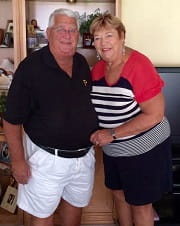The Challenge: An Enlarged Heart and Dangerous Heart Rhythm
Paul Jewell and his family know more about organ donation than most. When their young son passed away in 1981, they chose to donate his corneas.
Twelve years later — when Paul needed a heart transplant — he hoped someone else would make the selfless choice to help save his life.
In 1982, Paul was a busy 36-year-old husband, father, and bank vice president.
When he began feeling run down — despite being in good shape from playing softball and racquetball — Paul decided to talk to his doctor.
Paul didn’t want to take any chances with his health. He’d recently lost a close friend to heart problems.
Paul’s doctor ordered a series of tests. The results showed an enlarged heart and a dangerous arrhythmia, or irregular heartbeat, and Paul returned home with a plan to manage his condition with medication.
Less than a year later, test results showed his irregular heartbeat had returned.
Paul’s doctor prescribed a combination of two drugs, which worked for him for the next 10 years.
The Path to the UPMC Heart Transplant Program
In May of 1993, Paul returned home from a business trip with what he thought was bronchitis. It turned out to be severe congestive heart failure.
A series of dramatic events — including multiple instances of cardiac arrest and hospital transfers — led to Paul’s arrival at UPMC Presbyterian.
Doctors at UPMC believed that Paul’s best chance to survive was a ventricular assist device, or VAD. The VAD would take over the work of his heart until a transplant.
After a procedure to treat his abnormal heart rhythm, Paul was stable enough to undergo VAD implant surgery.
The Solution: LVAD as a Bridge to Transplant
In the early 1990s, large machines connected to VADs to keep them running. This meant VAD patients remained in the hospital until transplant.
Spending nearly five months at UPMC Presbyterian, Paul and his family became very close to the doctors, nurses, and other members of his care team.
“The people at UPMC were extremely kind to us,” says Paul. “We truly appreciated everything they did for our family.”
On the night of October 6, 1993, Paul had a heart transplant with the UPMC’s Artificial Heart Program and UPMC’s Heart Transplant Program team.
Paul had a remarkably fast recovery. He left the hospital just fifteen days after his heart transplant.
The Result: Spreading the Word About Organ Donation
To his donor, and his donor’s family, Paul will always be grateful.
He takes every chance to spread the word about how organ donation transformed his life. And he's actively involved with CORE, the Center for Organ Recovery and Education.
Paul and his wife now live in Erie, minutes away from their son, daughter, and seven grandchildren.
Paul stays busy with his family and in his role as president of the Hamot Aide Society, which provides volunteer support to UPMC Hamot.
Paul's treatment and results may not be representative of similar cases.
Read more heart transplant patient stories
Learn More About Heart Failure and Heart Health
UPMC Heart and Vascular Institute:
















